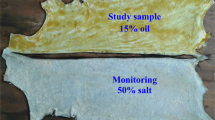Abstract
The aim of the present study was to evaluate cetyltrimethylammonium bromide (CTAB) as a short-term preservative agent for stripped goat skin, as an alternative to common salt (sodium chloride), the presently used preservative in the leather industry. Bacteria were isolated from the stripped goat skin at various time intervals and 16S rDNA sequencing results showed the presence of both Gram positive and Gram negative bacteria in stripped goat skin. All the bacterial isolates were inhibited by CTAB with MICs of 0.5–24.5 mg l−1. Application of CTAB against microbial consortium on stripped goat skin showed that skin sample kept in 5% CTAB solution for 10 min did not contain any bacterial growth even after 12 days storage at room temperature. Scanning electron microscopy analysis and physical testing of skin preserved using CTAB did not reveal any bacterial attack on fiber structure of skin. This study shows that CTAB can be applied as a viable alternative to NaCl which generates a huge amount of pollution there by reducing pollution from leather processing.




Similar content being viewed by others
References
Altschul SF, Madden T, Schaffer AA, Zhang J, Anang Z, Miller W, Lipman DJ (1997) Gapped BLAST and PSI-BLST: a new generation of protein database search programs. Nucleic Acids Res 25:3389–3402. doi:10.1093/nar/25.17.3389
Anon (1993) In: Cook RL (ed) Microbiological methods for the meat industry, 2nd edn. Meat Industry Research Institute of New Zealand, Hamilton
Birbir M, Ilgaz A (1996) Isolation and identification of bacteria adversely affecting hide and leather quality. J Soc Leather Trade Chem 80:147–153
Birbir M, Kallenberger EW, Ilgaz A, Bailey DG (1996) Halophilic bacteria isolated from brine-cured cattle hides. J Soc Leather Technol Chem 80:87–90
BIS standards (1971) Physical testing of leather, pp 2–70
Brannon DK (1997) Cosmetic microbiology: a practical handbook. CRC Press, Inc., Boca Raton
Eaton AD, Clesceri LS, Greenberg AE (1995) Standard methods of the examination of water and wastewater, 19th edn. APHA, Washington, DC
Kallenberger EW (1984) Halophilic bacteria in brine curing. J Am Leather Chem Assoc 79:104
Kanagaraj J, Babu NKC, Sadulla S, Rajkumar VS, Visalakshi G, Kumar NK (2000) Cleaner techniques for the preservation of raw goat skins. J Clean Prod 9:261–268. doi:10.1016/S0959-6526(00)00060-3
Kanagaraj J, Babu NKC, Sadulla S, Rajkumar VS, Visalakshi G, Kumar NK (2001) A new approach to less-salt preservation of raw skin/hide. J Am Leather Chem Assoc 95:368–374
Kanagaraj J, Sundar VJ, Muralidharan C, Sadulla S (2005) Alternatives to sodium chloride in prevention of skin protein degradation- a case study. J Am Leather Chem Assoc 13:825–831
McBain AJ, Ledder RG, Moore LE, Catrenich CE, Gilbert P (2004) Effects of quaternary ammonium based formulations on bacterial community dynamics and antimicrobial susceptibility. Appl Environ Microbiol 70:3449–3456. doi:10.1128/AEM.70.6.3449-3456.2004
Mereghetti L, Quentin R, Van Der Mee NM, Augury A (2000) Low sensitivity of Listeria monocytogenes to quaternary ammonium compounds. Appl Environ Microbiol 66:5083–5086. doi:10.1128/AEM.66.11.5083-5086.2000
Mondal NC, Saxena VK, Singh VS (2005) Impact of pollution due to tanneries on groundwater regime. Curr Sci 88:1988–1994
Orlita A (2004) Microbial biodeterioration of leather and its control. Int Biodeterior Biodegrad 53:157–163. doi:10.1016/S0964-8305(03)00089-1
Paulus W (2006) Directory of microbicides for the protection of materials. A Handbook. Springer, The Netherlands
Perrière G, Gouy M (1996) WWW-query: an on-line retrieval system for biological sequence banks. Biochimie 78:364–369. doi:10.1016/0300-9084(96)84768-7
Rajamani S (1998) Cleaner tanning technologies in the beam house operation. Proc Symp Cleaner Tanning Technologies UNIDO
Shede PN, Kanekar PP, Polkade AV, Dhakephalkar PK, Sarnaik SS (2008) Bacterial succession on raw buffalo hide and their degradative activities during ambient storage. Int Biodeterior Biodegrad 62:65–74. doi:10.1016/j.ibiod.2007.12.007
Thompson JD, Gibson TJ, Plewniak F, Jeanmougin F, Higgins DG (1997) The ClustalX windows interface: flexible strategies for multiple sequence alignment aided by quality analysis tools. Nucleic Acids Res 24:4876–4882. doi:10.1093/nar/25.24.4876
Vankar PS, Dwivedi AKR (2008) Sulphates for skin preservation—a novel approach to reduce tannery effluent salinity hazards. J Hazard Mater doi: 10.1016/j.jhazmat.2008.06.090
Acknowledgments
The authors thank the Council of Scientific and Industrial Research (CSIR), India for funding the research through the New Millennium Indian Technology Leadership Initiative (NMITLI) Project “Biotechnology for Leather: Towards Cleaner Processing” (No. 5/258/13/2002-NMITLI; P6131105) and the computational and bioinformatics facility provided by the Alagappa University Bioinformatics Infrastructure Facility (funded by DBT, Govt. of India; No.BT/BI/04/2001).
Author information
Authors and Affiliations
Corresponding author
Rights and permissions
About this article
Cite this article
Babu, T.G., Nithyanand, P., Babu, N.K.C. et al. Evaluation of cetyltrimethylammonium bromide as a potential short-term preservative agent for stripped goat skin. World J Microbiol Biotechnol 25, 901–907 (2009). https://doi.org/10.1007/s11274-009-9969-6
Received:
Accepted:
Published:
Issue Date:
DOI: https://doi.org/10.1007/s11274-009-9969-6




